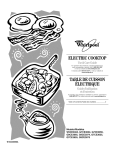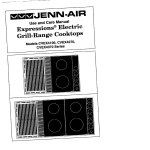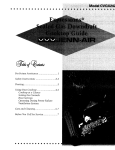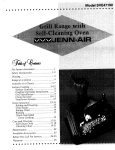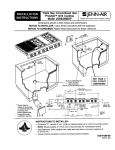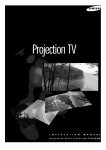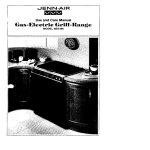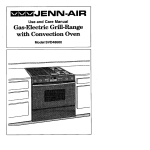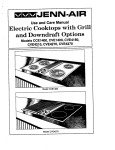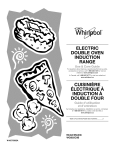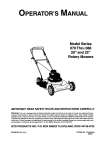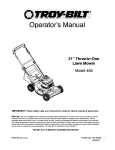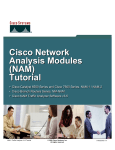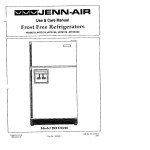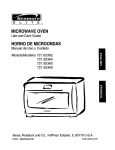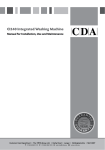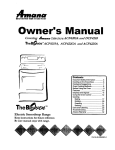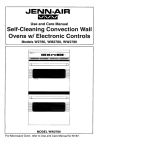Download Jenn-Air SVE47600 User's Manual
Transcript
mJENN.AIR
Use and Care Manual
Gl_ll-Range with
Self-Cleaning Conventional
and Convection Oven
Models SVE47500 and SVE47600
Model SVE47600
i
/
Congratulations on your choice of a Jenn-Air grill-range. The indoor grilling
of meats, fish or fowl is one of the most attractive and succulent methods
of preparing these foods ... a unique flexibility made possible by Jenn-Air's
patented integral ventilation system.
Your Jenn-Air self-cleaning oven combinesthe best of fourcooking methods,
conventional baking or roasting, convection baking, convection roasting and
broiling. (Note; Only Model SVE47600 has the convection options.)
The Jenn-Air convection oven is actually a conventional oven that circulates
heated air within the oven. As both bake and broil heating elements cycle on
and off with the thermostat, a fan keeps the heated air circulating around the
food. The constantly recirculating heated air in the convection oven strips
away the layer of cooler air that surrounds the food. Consequently, many
foods cook more quickly. Evenly distributed heat makes multiple rack
cooking possible. Convection roasted meats retain their natural flavor and
juiciness with less shrinkage than conventional roasting.
In addition to the many exclusive benefits of convection cooking, your JennAir oven is also a fine full featured conventional bake and broil oven. You can
cook your "old favorite" recipes as you have in the past. The conventional
bake oven also gives you the flexibility of preparing various foods when
convection cooking may not be as beneficial, as when cooking foods in
covered casseroles or clay pots. The broil element is convenient for top
browning and oven broiling of foods.
Before you begin cooking with your new range, please take a few minutes to
read and become familiar with the instructions in this book. On the following
pages you will find a wealth of information regarding all aspects of using your
new range. By following the instructions carefully, you will be able to fully
enjoy and properly maintain you r range and achieve excellent resultswith the
food you prepare.
Should you have any questions about using your Jenn-Air range or need a
Use and Care manual for your cooktop cartridge, write to us. Be sure to
provide the model number.
Jenn-Air Customer Assistance
c/o Maytag Customer Service
P,O, Box 2370
Cleveland, TN 37320-2370
Appliance Usage
BeforeYou Cail for Service .......................................................................................... 46-48
Caring for your Range
Access Panel .............................................................................................................
44
Adjust Oven Temperature ..........................................................................................
44
Child ProtectionLock .................................................................................................
43
Cleaning Other Parts of Your Range ..................................................................... 42-43
Oven Light Bulb .........................................................................................................
45
RangeComponents .............................................................................................................
8
Safety Precautions ...........................................................................................................
4-7
Using the Cooktop and Grill
Accessories ..................................................................................................................
50-51
CooktopCartridges
Home Canning ...........................................................................................................
11
[nstallation .................................................................................................................
11
Cookwaro ..........................................................................................................................
12
DuctingInformation ...........................................................................................................
49
Gdiling
Cleaning ................................................................................................................
16-17
Grilling Guide ..............................................................................................................
15
GrUlingTips ................................................................................................................
16
Installation..................................................................................................................
13
Usage .........................................................................................................................
14
Surface Controls................................................................................................................
10
Ventilation System ...............................................................................................................
9
Using the Oven
Baking
Baking Chart ..............................................................................................................
27
Causes of Cake Failure .............................................................................................
28
Convect Baking.....................................................................................................
28-29
General Recommendations .......................................................................................
26
Broiling .........................................................................................................................
34.35
Clock Controls
Clock ControlledBaking or Roasting .................................................................... 24-25
Time of Day Clock .....................................................................................................
22
_mer .........................................................................................................................
23
Oven Cleaning
Self-Cleaning Process ..........................................................................................
36-41
Oven Operation
Oven Control Panel ...............................................................................................
18-19
F_ck Positions ...........................................................................................................
21
SettingControls .........................................................................................................
20
Roasting
Convect Roasting ......................................................................................................
32
Frozen Convenience Foods ....................................................................................... 33
Roasting Chart ...........................................................................................................
31
General RoastingRecommendations ........................................................................ 30
3
Read before operating your range
All appliances -- regardless of the manufacturer -- have the potential
through improper or careless use to create safety problems. Therefore the following safety precautions should be observed:
1. Be sure your appliance is properly installed and grounded by a
qualified technician.
2. Never use your appliance for warming or heating the room.
3. Children should not be left alone or unattended in area where
appliance is in use. They should never be allowed to sit or stand
on any part of the appliance.
4. Wear properapparel. Loose-fittingorhanginggarmentsshould
never be worn while using the appliance.
5. Do not repair or replace any part of the appliance unless
specifically recommended in this manual. All other servicing
should be referred to an authorized Jenn-Air Service Contractor.
6. Flammable materials should not be stored in an oven or near
surface units.
7. Do not use water on grease fires. Smother fire or flame or use
dry chemical or foam-type extinguisher.
8. Use only dry potholders. Moist or damp potholders on hot
surfaces may result in burns from steam. Do not let potholder
touch hot heating elements. Do not use a towel or other bulky
cloth.
g. Use proper pan size. Many appliances are equipped with one
or more surface units of different size. Select cookware having
flat bottoms large enough to cover the surface unit heating
element. The use of undersized cookware will expose a portion
of the heating element to direct contact and may result in
ignition of clothing. Proper relationship of cookware to heating
element will also improve efficiency and performance.
10. Never leave surface units unattended at high heat settings. Boil
over causes smoking and greasy spillovers that may ignite.
4
11.Glazed cookwara-- only certaintypesof glass, glass-ceramic,
ceramic, earthenwareorotherglazed cookpotsare suitablefor
rangetopsurfacewithoutbreakingdue to the suddenchange
intemperature.Useonlysuchcookwareas youknowhasbeen
approvedfor this purpose.
12.Cookwara handles should be turned inward and not extend
overadjacentsurfaceheatingelementstoavoidbums,ignition
of flammablematerialsandspillageduetounintentionalcontact
withthe cookware.
13.CAUTION -- Do not store items of interest to children in
cabinets above a range or on the backguard of a range -childrenclimbingontherangeto reachitemscouldbeseriously
injured.
14.Do notsoakor immerseremovableheatingelements inwater.
15.Donottouchsurfaceunitsorareasnearunits,heatingelements
or interior surfacesof oven. Surface units or heatingelements
may be hot even though they are dark in color. Areas near
surface units and interior surfaces of an oven may become hot
enough to cause burns. During and after use, do not touch or
let clothing or other flammable materials contact these areas
until they have had sufficient time to cool. Other surfaces may
become hot enough to cause burns --among these surfaces
are the cooktop,the upper door frame and glass, oven vent
openingandsurfacesneartheopening,andthetopedgeof the
controlpanel.
16. Usecarewhenopeningovendoor. Lethotair orsteamescape
before removingor replacingfood.
17.Do not heat unopenedfood containers. Build-upof pressure
may causecontainerto burstand resultin injury.
18.Keep ovenvent ductsunobstructed.The ovenvent is located
underneaththe air grille.
19.Always placeovenracksindesiredlocationwhileoveniscool.
If rack must be moved while oven is hot, do not let potholder
contacthot heatingelement in oven.
21).Donot clean door gasket. The door gasketis essentialfor a
good seal. Care shouldbe taken not to rub, damageor move
the gasket.
21.Do not use oven cleaners. No commercialoven cleaner or
ovenlinerprotectivecoatingof any kindshouldbe used in or
aroundany part of the oven.
22.Clean only parts listed in this manual and use procedures
recommended.
23. CAUTION: BEFORESELF-CLEANINGTHEOVEN, REMOVE
FOOD, BROILER PAN AND OTHER UTENSILS.
24.Listenforfan. A fan noiseshouldbeheard duringthe broiland
cleaningcycles. If not,call a servicemanbeforeself-cleaning
again.
25. Do notcookon glass-ceramiccookingsurfaceifthe cooktopis
broken. Cleaning solutionsand spilloversmay penetratethe
broken cooktop and create a shock hazard. Contact an
authorizedJenn-AirServiceContractor.
26.Clean glass-ceramiccooktopswithcaution. If wet spongeor
clothis usedto wipe spillson a hot cookingarea, be carefulto
avoid steam burns. Some cleansers can produce noxious
fumes if appliedto a hot surface.
27.Do not operate with damaged cooking element after any
productmalfunctionuntilproperrepairhas been made.
28.Keep all switches"OFF" when unitis not in use.
29.Do not allowaluminumfoilto contactheatingelements.
30. On conventionalelementcartridgesmake sure thatdrip pans
are in place. Absence of these pans during cookingmay
subjectwiringor componentsunderneathto damage.
31. Donotusealuminumfoil toline surface unitdrip pans,grillbasin
orovenbottom.Installationofthese linersmay resultinelectric
shockor fire hazard.
32.WARNING: To reducethe riskof tippingofthe appliance,the
appliancemustbesecuredbyproperlyinstalledanti-tipdevices.
To checkif devicesare installedproperly,removethe access
panel and verifythat the anti-tipdevicesare engaged.
33.This appliance has been tested for safe performance using
conventional cookware. Do not use any devices or accessories
that are not specifically recommended in this manual. Do not
use eyelid covers for the surface units, stovetop grills, or addon convection systems. The use of devices or accessories that
are not expressly recommended in this manual can create
serious safety hazards, result in performance problems, and
reduce the life of the components of the appliance.
34.PREPARED FOOD WARNING: Follow food manufacturer's
instructions. If a plastic frozen food container and/or its film
cover distorts, warps or is otherwise damaged during cooking,
immediately discard the food and its container. The food could
be contaminated.
IMPORTANT SAFETY NOTICE AND WARNING
The California Safe Drinking Water and Toxic Enforcement Act of 1986
(Proposition 65) requires the Governor of California to publish a list of
substances known to the State of California to cause cancer or reproductive harm, and requires businesses to warn customers of potential
exposures to such substances. Users of this appliance are hereby
warned that when the range is engaged in the self-clean cycle, there
may be some low level exposure to some of the listed substances,
including Carbon Monoxide. Exposure to these substances can be
minimized by properly venting the range to the outdoors during the
self-clean cycle.
- SAVE THESE INSTRUCTIONS 7
Oven Vent
Controls
Surface,
Lights
Controls
Indicator
Lights
Controls
•
Use to capture smoke and steam. (See p. 9.)
•
Will glow when a surface unit is on. (See p. 10.)
•
Use to provide flexibility in setting selection when using the cooktop elements or grill
elements. (See p. 10.)
•
Use the electronic touch controls to set Clock or Oven functions. (Clock - see pp.
22-25, Oven Operation - see pp. 18-21.)
The built-inventilation system removes cookingvapors, odors andsmoke fromfoodsprepared
on the cooktop, gri}}and grill accessories. Regular use of this system wilt insure a more
comfortableand less humidl,_¢tchen
whichisftee of heavy coakingodorsand fumes thatnormally
create a frequent need for cleaningand redecorating,
i
• Thedowndraftventilationsystemfeaturesatwospeedfan.
The fan positionsare: Hi, Lo, and OFF. To turn on the
ventilation system, touchthe Fan Pad. The fan wi({come on
at the Hi speed. To set on Lo speed, touch the Fan Pad
(once from Hi settingor twice from the OFF position).
• A beep willsound every time the Fan Pad is touched.
• To turn the ventilationsystem OFF, touch the Fan Pad (oncefrom Lo speed or twice from
Hi speed).
• The ventilationsystem will operate automatical/y on Hi speed when the gdll element is in
use. During grilling, the fan speed is automatically set for the Hi setting AND cannot be
changed to Lo speed.
• Use the HI fan speed for capturing steam. Use Lo fan speed for capturing smoke when
pan frying.
• The fan can beused to remove strongodorsfrem the kitchenas whenchoppingonions near
the fan.
• _,esides usingthe ventilation system to remove cookingvaporsandfumes, it can be used
tocoolbaked pies or cakes, To cool an item, set iton the air gdlle and turn on the fan. The
air being pulledover the item willquicklycool it. Be careful not to cover the oven vent or
the entire air gdne,
Air Grille
The air grille lifts off easily. Wipe clean or wash in sink with mildhousehold deten:jents.It may
be cleaned in the dishwasher. Note:The oven vent is located under the air grille. When using
orcleeningtheoven, hotandmoistairmaybenoticedinthisarea. 13ecareful notto spillanything
into this vent. Remove the air grille before self-creaningthe oven. (See p. 36.)
Filter
Turn offventilationsystem before removing. The filter isa permanent
typo and shouldbe cleanedwhen soiled. Clean in sink with warm water
and liquid dishwashing detergent or in dishwasher. Important: Filter
should aMays be placed at an angle. As you face the front of the range,
the top of the filter should rest against the left side of the vent opening
and the bottom of the filter should rest against the right side of the
ventilation chamber at the bottom. DO NOT OPERATE SYSTEM WITHOUT FILTER.
Ventilation Chamber
This area, whichhouses the filter, shouldbe cleaned in the eventof spills or whenever it becomes
coatedwith a filmof grease, It may be cleaned with papertower,damp cloth,or sponge end mild
householddetergent.
9
• Sincethe controlsare a push-turntype, theymust bepushed down before turning. To set
(from the OFF position), push down on the control knob and turn in either direction to
desired setting.
• Whenthecontrolisinanyposition,otherthanOFF, itmaybeturnedinanydirectionwithout
pushingdown.
• A green indicator lightwill glowwhen a surface heating element is ON. There are four
indicator lights, one for each element.
1.
2.
_.
4.
1. Left rear eJement(rear Energy-Saver or standard griIJ)
2. Leftfront element (frontEnergy-Saver)
3. Rightfront element (front Energy-Saver or standard grill)
4. Right rear element (rear Energy-Saver)
NOTE: The "Energy-Saver"grillelement (right)is includedwith Model
SVE47600and maybepurchasedas anoptionforothermodels.Itpermits
utilizingonlyhalfof thegrillarea,if desired,orusingdifferentsettingsfor the
front and rear positionof the element. When usingthis element, both
cooktopcontrols,frontandrear,mustbe turnedon in orderto use the furl
grillarea.
NOTE SVE47E00 Model: Onlythe left rearor the rightfrontcontrolsmust
beturnedonto usethe full grill.
The size andtype ofcookware and the amount andtype of food beingcooked will influencethe
settingneeded for bestcooking results. Electricalvoltage may also vary, which will affect the
needed controlsetting. The settingindicatedshouldserve as a guidewhile youbecomefamiliar
with your range.
Hi
7-10
5-6
3-4
Lo-2
A fast heat to start cooking quickly, to bring liquids to a boil, to preheat oil for deep
fat hying. Use for most grilling.
(Medium High) For fast frying or browning foods, to maintain rapid boll of large
amounts of food, to maintain oil temperature for deep fat frying.
(Medium) For foods cooked in a double boiler, saut6ing, slow boil of large
amounts of food, and most frying.
(Medium Lo) To continue cooking foods started on higher settings.
Maintaining serving temperatures of foods, simmering foods, melting butter or
chocolate.
The controlsoffer flexibilityin settingselection. On settings other than Hi, you may adjustthe
controlaboveor belowthe numberedsetting forbestresults.This appliesto settingswhenusing
cooktopcartridgesor when usingthe grillor any of the grillaccessories. Suggested settingsare
providedas generalguidelines.
10
Cooktopcartridges,either conventionalcoil, halogen, radiantor solid element,can be
installedon eitherside ofthe range. (See page 51 for allavailablecartridgesand model
numbers.)
To Install Cartridges
1.
2.
3.
4.
If the grill element, grin-rocksor grates are in place, remove before installinga
cooktopcartridge. Clean pomelain basinpan of any grease accumulation. (See
page 17 for cleaningrecommendations.)
To installany of the optionalcooktopcartridges,be sure controlsare turned OFF.
Positionthe cartridgeterminalplugtowardstheterminalreceptacle.Thisreceptacle
is located at the front of the left side and at the backof the rightside of the range.
Slide the cartridge towards the receptacle until the cartridge terminal plug is
completelyengaged.
Lowerthe oppositeend of the cartridge intothe rangetopuntil it is flush with the
surface. Your range is now ready to use.
To Remove Cartridges
1.
2.
3.
4.
5.
Controls must be OFF and the cartridge should be cool.
Lift up on the "tab" locatedon the cartridgeuntiltop of cartridgeclearsthe opening
on the rangeby about2 inches. Liftingthe cartridgetoo highwhilestillengagedin
the receptaclecoulddamage the terminal plug.
To disengageterminal,holdcartridgebythe sidesand slideawayfromthe terminal
receptacle. Liftout when fully unplugged.
A storagetray, Model A350, is availableand can be used for storinga cartridge.
Do not stack cartridges where they may fal[ or be damaged. Never store other
materialson top of the glass-ceramiccartridgessincethis coulddamage or scratch
the surface.
Canning should be done on the conventionalcoil cartridgeonly. Canning element
accessory,ModelA145A, makes it possibleto use largecannerswiththe conventional
coil cartridge.
11
• Select heavy gauge cook,pots. Usually heavy gauge cookpotswill not change
shape when heated.
• Use cookpots with flat, smooth bottoms. The twoways todetermineif cookpots
have a flat, smoothbottomarc the rulertest and the cookingtest.
Ruler Test
1. Place theedge of ruleracross the bottom
of the pot.
2. Hold up to the light.
3. No lightshouldbe visibleunderthe ruler.
/f,,-_
_
Cooking Test
1. Put 1 inchof water intothe cookpot.
2. Place cookpoton the element. "rumcontrolto the Hi setting.
3. Observethe bubbleformationto determinethe heatdistribution,if thebubbles
are uniformacross the cookpot,the cookpotwillperformsatisfactorily.If the
bubblesare not uniform,the bubbleswill indicatethe hot spots.
• Match the size of the cookpot to the size of the element, ideally the cookpot
will be the same size or slightlylarger.
Heavy gauge cookpotswith fiat, smooth bottomswill usuallywork in a similar way.
However,there are some differencesin the cookingperformanceof variousmaterials.
• Aluminum cookpotsheat quicklyand evenly. Best suitedfor simmering,braising,
boilingand frying.
• Stainless steel cookpots w_ll evenly distribute heat if constructed of td-ply or
combinedwith other metals such as aluminum and copper. Use for cooking
functionssimilarto aluminum.
• Cast iron cookpotsare slow to heat but cook more evenly once temperatureis
reached. Use for long term low heat cookingor for browningand frying.
• Glass ceramic, earthenware, heat-proof glass or glazed cookpots can be used if
recommendedby the manufacturerfor cookpotcooking. Do not use with trivets.
Best used on low to mediumcontrolsettings.
• Porcelain enamel-on-steel or porcelain enamel-on-cast iron should be used
accordingto manufacturer'sdirections. Do not allowto boil dry.
12
The grillaccessoryconsistsof twoblackgrillgrates,a grillelement,and two grill-rocks.
To Install Grill
1. Before installing grillcomponents,be certain controlsare OFF.
2. Placethe two gritl-rocksintoan emptybasinpan withtheirhandlesrunningparallel
to thefrontofthe range. These grill-rocksmustbe used sincethey supportthe grill
element.
3. Positionthe grill element with the terminal plugtowardsthe terminal receptacle.
This receptacleis locatedat thefrontofthe leftside and at the backofthe rightside
of the range. Slidethe element towardsthe receptacleuntilthe terminalplug is
completelyengaged. The grillelement shouldnow reston the handlesof the grillrocks.
4. Place the blackgrillgrates on the top of the rengetop.
To Remove Grill
1. Remove grillcomponentsonce they are cool. Be sure controlsare OFF.
2. To remove grillelement, pull away from receptacleuntil it is unplugged. (Note;
Lifting the element more than 2 inches above the rangetopsurface while it is
engaged in the receptaclecoulddamage the terminal plug.)
3. A storagetray, Model A350, is availablefor purchaseand can be usedfor storing
the grillassembly.
Installing Other Grill Accessories
1. Remove the two black grill grates from the grill. Now you are ready to use the
optionalgrill accessories.
2. RevLewthe instructions
for installingand usingthe accessoriesthat are packaged
with the accessory.
Note: Accessoryoptionsare shownon page 50.
13
• Before the first use, wash your new grill grates in hot soapywater, rinse and dry.
Then "season" the surface by wiping on a thin coating of cooking oil. Remove
excess oil by wiping again with another paper towel. This procedureshouldbe
repeated when either: a) cleaning in the dishwasher since the detergent may
removeseasoning,or b) anytime a sugar-basedmarinade (for example, barbecue
sauce) is going to be used.
• Preheat the grill on HI for 5 minutes. Preheating improves the flavor and
appearance of meats and quicklysears the meat to help retain the juices. The
heating element shouldglow a brightcherry red.
• Usenonmetallicspatulasorutensi/stopreventdamagingtheExcalibur®nonst/ck
grill grate finish.
• Excessive amounts of fat should be trimmed from meats. Only a normal amount
is necessary to producethe smoke needed for that smoked, "outdoor" flavor.
Excessivefat can create cleaning and flare-up problems.
• Allowing excessive amounts of grease or drippings to constantly flame voids the
warranty on the grill grates. Excessiveflare-upsindicatethat eitherthe grillinterior
needs to be cleaned or that excessive amounts of fat are in the meat or the meat
was not properlytrimmed.
• Grease drippingswill occasionallyigniteto produceharmlesspuffsof flame for a
second or two. This is a normal part of the cookingprocess.
• NEVER LEAVE GRILL UNATTENDED DURING GRILL OPERATION.
Should excess grease cause sustained
1. Turn on FAN manually.
2. Immediatelyturn grillcontrol(s)to OFF.
3. Remove meat from gdll.
flare-up
IMPORTANT
•
•
•
•
Do not use aluminumfoil insidethe gri, area.
Do not use charcoalor wood chipsin the grill area.
Do not allow gdll-recksto become overloadedwith grease. Clean frequently.
Do not covergratescompletelywithmeat. Leave air space betweeneachsteak,
etc. to allow proper ventilationas well as prevent flare-ups.
14
15
Withyour J enn-Air grilland accessories, literallyany food you've considered"at itsbest" when
preparedoutdoorscan now be prepared indoors with lessfussand greatflavor. The following
suggestionsare good rules to follow and will increase yourenjoyment of the equipment.
• Be sure to follow directions on page 14 for usingthe gdti.
• Suggestedcookingtimesandcontrolsettingsareapproximateduetovariationsinmeate.
Experience will quickly indicate cooking times as well as which settings work best.
• Use the Energy-Saver grillelement for grillingsmall amounts of food on halfofthe gdllor
for keepingcookedfoodswarm orpreparingfoodsrequiringdifferentcontrol settings.Note
SVE47500 Owners: The Energy-Saver grill element can be purchased as an optional
accessory. (See p. 50.)
• For bestresults, buytop grade meat. Meat that is at least 3/_inch thickwill grill better than
thinner cuts.
• Score fat on edges of steak, but do not cut into meat, to prevent cuding while cooking.
• For the attractive "branded"look on steaks, be sure grill ispreheated. Allow one side of
meat tocooktodesireddoneness, or untiljuices appearon the topsurface, before turning.
Tum steaks and hamburgers just once. Manipulatingfood_?,_uses
loss of juices.
• When bastingmeats orapplying saucesto foods, remember that excossiveamountswind
up insideyour grill and do not improve the food flavor. Apply sauces during the last t 5 to
20 minutesof cookingtime unless recipespecifiesotherwise. Sugar-based sauces,when
used excessively,wilJcarmelize on the grill-rocksand create extra cleaning.
• There are many meat marinades whichwill help tenderize less expensive cutsof meat for
cookingon the grill.
• Certain foods, such as poultryand non-oilyfish, may need some extra fat, Brush with oil
or melted butter occasionallywhile grilling.
• Use tongswithlong handlesorspatulas fortuming meats. Do notuse forksas these pierce
the meat, allowing juices to be lost.
• To help retain meat juices, salt after cookingis completed.
• Should grilledfoods be preparad and ready before you're ready to serve, turncontrol to a
lowsettingand covermeat with a singleshset of aiuminum foil. Foodwill continuetocook.
Be sure the grillis cool and controlsare OFF.
Grill Grates
These are made fromcast aluminumand are coated with the Excelibur_ nonstickfinish.
• Afterthe grillgrates havecooled, wipe offgrateswith a paper towel Wash coolgrates (DO
NOT IMMERSEHOTGRILL GRATES IN WATER) withsoapordetergent inhot water in the
sinkorwashtheminthedishwasher. Beeureto removeall foed residuebeforecooking on
the grillgrates again.
• Removestubbomspotswithaplasticmeshpufforped.
Forbestresults, useonlythose
cleaning productswhich state they are recommended for use when cleaning nonstick
agrraces.
• It grates were washed in the dishwasher, season with oilpriorto grilling. (See p. 14.)
• Donotusernetalbmshesorabrasivescouringpadsorotherscrubbersintendedtoclean
outdoor charcoal gril/s. These will remove the finish as well as scratchthe grates. Do not
clean in self-cleaning oven or use oven cleaners on the grates.
f6
Grill Element
Follow instructions on page 13 for removing the griflelement. The grillelement shouid never
be immersed in water. Most soil will burn offduring use, The terminal block may be cleaned
with a soapy sponge. Dry thoroughly before reinserting in the range.
Grill-Rocks
These are made from cast-iron which have been coated with porcelain enamel.
• The grill-rocksshould be cleaned frequently or after any excessive build-up of grease.
To clean tight soil, use detergent and a plastic scrubber, such as Tufty, or wash in the
dishwasher if burned on residue isfirstremoved. For heavysoil, soak inhot, soapywater
to which a cleanser, such as household ammonia, has been added. Stubborn spots on
grill-rocks,such as burned on residue from sauces, can be scrubbed with a stiffbristle
brush.
• An ovencleaner, such as Easy-Off, can be used forburned onsoil. Followmanufacturer's
directions;spray on cleaner and letsoak overnight. Do not clean grill-rocks in the selfcleaning oven.
Porcelain Basin Pan
This area located under the grill-recks and/or cartridges. Clean after each use of the grill.
• To remove light soil, clean with soapy water or spray with cleansers such as Fantastik
or 409. For easier cleanup: a) spray with a household cleanser; b) cover with paper
towels; c) add small amount of hot water to keep the paper towels moist; d) cover and
wait 15 mlnutas; and e) wipe clean.
• To remove moderate soil, scrub with Comet, Son Ami, a soft scrub cleanser or plastic
scrubber.
• To remove stubborn soil, spray with an oven cleaner such as Easy-Off; let soak
overnight, wipe clean, rinse and dry.
Note: Clean the grease drain after each use. To clean: Pour about 1/3 cup of very hot tap
water mixed with 1 teaspoon dishdetergent down the drain. In the event the drainis clogged,
due to large food particles being trapped, use the nylon stringthat was packaged with your
range. To use the nylonstring, simplyinsert one end intothe drainopening inthe basin pan.
Feed the nylonstringdown untilit isvisible underthe range. Now pullup onthe end extending
out fromthe top while holding a paper towel around the string, toclean the stringas it isbeing
pulled. Thisshould freeanytrappad particlesoffood. Pouranother 1/3cupofveryhotwater
mixed with dish detergent to assure the drain is opened and clear.
Grease Containers
The containers are locatedbehindthe bottomaccess panel, underneaththe range. (See page
44 for opening access panel.) There is onecontainer forthe left side andone for the rightside.
They collect grease and other liquids created white gri((ingor using some of the accassor[es.
Check each time after grilling and empty when grease is noticeable. To remove, simplygrasp
• Check the container periodicallytoprevent grease from spilling
over. If this should happen, the grease will flow over the
container andontothefloor. The containerandscrew-on handle
can be washed in hot, soapy water or in the dishwasher. The
container can be replaced with any heat tempered jar, suchas
a canning jar, which has a standard screw neck.
thehandle, andpullfromthebracketholdingthecontainer.__
17
The control panel is designed for ease in programming, The Display Window features
Indicator Words which will flash to prompt you for the next step.
To program
1. Touch the function pad to give command desired.
2. Touch the appropriate number pads to enter time or temperature.
Note: Four to fifteen seconds after entering the number, the time or temperature
will automatically be entered. If more than fifteen seconds elapse between touching
a function pad and touching a number pad, the control is not set and Display will
return to previous Display.
=,;*_.==NN-_tR
O_erl
cor_tto_
I_c_en 1liner
Function Pads
Use forconventionalbakingor roasting.
Usefortop browningoroven broiling.
Useto setself-cleaningprocess.
Useforconvectroasting.(ModelSVE47600 only)
Use forconvect baking. (Model SVE47600 only)
Use for clock controlled cooking and cleaning when delayed start isdesired.
(For lock function see page 43.)
Usefor clock controlled cooking.
(For lock function see page 43.)
Cancels all programming except Timer.
Use to turn the Ventilation System on or off, (See p. 9.
Useto signal expiration of a time period up to 11 hours and 55 minutes.
Useto signal expiration of a time period up to 11 hours and 55 minutes.
Use to set time of day.
Use to turn oven light on and off,
18
Number Pads
Use to set time or temperature.
Oven Light Pad (Control Panel)
The oven lightautomaticallycomeson wheneverthe oven door isopened. When door
is closed, touchthe Oven Light Pad to turnoven lighton or off.
Display Window
Shows time of day, timer, and oven functions.
Display Numbers:
• Show time of day.
• Countdownof time remainingwhen usingtime functions.
• Show temperatureof oven as it risesto reach programmedtemperatureand the
set temperatureonce it is reached.
• Recall programmedtemperatureor time when commanded.
• Roundingof DisplayNumbers: Temperaturerange is100° to 550°Fand can be set
in 5° increments.When settingtemperature,the controlwill round itto the nearest
10°. Forexample, if237° isentered,the controlwillroundthe temperatureto 240°.
Prompts:
• Serve as a remindertoshutoven door,if itisopen,for self-cleaningoperationwhen
the word, door, is displayed.
• "Err" willappear in the Displaywhen an impropertemperature or time has been
entered. "Err"willflash and a beep willbe heardthree times. Then, the Displaywill
returnto the previousDisplaybefore the error was entered.
Indicator Words:
• Flashto promptnext step.
• Indicatestatusof programmedfunction.
• Show programmedfunctionwhen recalled.
Chimes vs. Beeps
• A chime soundis used to designatethe end of a timing or cookingoperation.
• A beep soundis usedto designatean incorrectentry,door is openwhen set for a
self-clean,and a fault code.
authorized Jenn-Air service contractor or installer.
NOTE: To changethe oven to a 24 hourclockor Celsius(C) degrees, contactyour
19
To set oven on Bake or Convect Bake or Convect Roast
1, Place oven racks on proper rack positions, (Bee p. 21,)
2, Touch Bake Pad or Convect Bake Pad or Convect Roast Pad,
Indicator Words BAKE or CONV BAKE or CONV ROAST will flash and three
dashes will be shown.
Note: If more than fifteen seconds elapse between touching a pad and touching a
number pad, Display will return to previous Display.
3. Touch the appropriate number pads for desired oven tempereture.
Allowable temperature range is 100° to 550°F. After four seconds the even will begin
to preheat. The Indicator Words ON, PREHEAT, and either BAKE or CONV BAKE
or CONV ROAST will appear in the Display. The temperature shown will be 100°
or the oven temperature whichever Is higher.
Example: If at 10 o'clock you set the oven for 350 ° for convect baking, after four
seconds the OJspJaywill show:
I,o:oo
During the preheat, the Display will show a rise in 5 ° increments until programmed
temperature is reached. When the oven is preheated, the oven will chime, the ON
and PREHEAT Indicator Words will go off, and programmed oven temperature will
be displayed.
Note: Oven will preheat for approximately 7 to 11 minutes.
Important:
Whenever ON appears in the Display, the oven Is heating.
To recall temperature set during preheat:
Touch the appropriate Bake or
Convect Bake Pad or Convect Roast Pad. Temperature will be bdefly displayed,
then will automatically return to on-goiog program.
To change temperature set: Touch appropriate Bake Pad or Convect Bake Pad
or Convect Roast Pad and the appropriate number pads for the new desired
temperature.
Note: If you are lowering the temperature below the current oven temperature, the
word PREHEAT and ON will appear briefly in the Display and the preheat chime will
sound. Then, the Display will show programmed temperature and indicator word
BAKE or CONV BAKE or CONV ROAST only.
4. Touch Cancel Off Pad to turn oven off at end of baking. The oven will continue
operating until the Cancel Off Pad is touched.
2o
The rack positionsnoted are generally recommendedfor the best browningresultsand
mostefficientcookingtimes. For many food items, excellentresultscan be achieved
when using one of several different reck positions. Refer to bakingand roastingsections
for recommendationsfor specificfoods.
Different Racks
One flat reck and one offset reck was packaged with your oven. The use of the offset
rack is denoted in the list below and the charts as an "o" after the rack number. Note
SVE47600 Owners: An additional flat rack was packaged in your oven.
i
4 (flat rack)
•
30 (offset rack)
1 (flat rack)
Rack Uses
Rack Position #40 (offset rack on #4):
Most broiling.
Rack Position #3:
Most baked goods on cookie sheets, cakes (sheet and layer).
Rack Position #30 (offset rack on #3):
Most baked goods on cookie sheets, frozen conveniencefoods, fresh fruit pie,
cream pie, layer cakes, main dish souffle.
Rack Position #2:
Roastingsmall cuts of meat, cakes (tube, bundt or layer), frozen fruit pie, pie shell,
large casseroles.
Rack Position #20 (offset rack on #2):
Roasting small cuts of meat, loaves of bread, angel food cake.
Rack Position #1 :
Large cuts ofmeat and large poultry,angel food cake, loaves of bread, custard pie,
dessert souffle.
Multiple Rack Cooking:
Two racks, use #2o and #4. Three racks,use #t,#3o, and #4.
21
When electrical power is supplied or after power interruption, the last clock time
displayed before power was interrupted will flash. Time will advance and continue to
flash until clock is reset.
To set Time of Day
1. Touch Clock Pad,
Indicator word TIME will flash and time digits will appear in the Display. (If morethan
fifteen seconds elapse between touching Clock Pad and touching a number pad,
the Clock Pad must be touched again in order to set clock.)
2. Touch the appropriate number pads until correct time of day appears in Display,
Note: Four to fifteen seconds after touching the number pads, the time of day will
automaticallv be entered.
IMPORTANT
•
To recall time of day when another time function is showing: Touch Clock Pad,
•
Clock time cannot be changed when oven has been programmed for Timed Bake,
Timed Convect Bake, Timed Convect Roast or Self-clean. Cancel program before
reprogramming clock.
22
Important: This intervalTimercan be used to remind you when a period, up to 11 hours
end 55 minutes,expires. It can be used independentlyof any other oven activity and
can be setwhile anotherovenfunctionisoperating. The Timer doesnotcontrolthe oven.
To set Timer
1. Touch a Timer Pad.
The indicatorWord Timer end either 1 or 2 flashes and "0Hr:00" appears in the
Display.
2. Touchthe appropriatenumberpads untilthe desired numberof minutesor hours
and minutesappear in the Display.
Note: If more than fifteen secondselapse between touchinga Timer Pad and a
numberpad, the Timer Pad must be touched again.
Example: To set Timer One for 5 minutes,touch the Timer One Pad and the
number5 pad. After fifteen seconds,the displaywillshow:
:135
TIMBq
[
Example: To set TimerTwo for 1 hour and30 minutes,touchtheTimer Two Pad
and the numbers t, 3, 0 pads. After fifteenseconds,the Display will show:
I !,3o
I
Countdownwillstart after fifteen seconds. Countdownwillhave displayprecedence
over other time functions. If both timers are set, the timer with the least amount of
time remaining will have display precedence.
At the end of time set, the Timer will chime four times and "End" will appear in the
Oisplay. If timer is not cancelled (see below), "End"will remain in the Display and
there will be two chimes every thirty seconds for five minutes.
To cancel Timer
1. Touch and hold the Timer Pad for fourseconds.
OR
2. A. Touchthe Timer Pad.
B. Touch "0" numberpad. Fifteen secondslater the Timer will be cancelled.
programming.
NOTE: TouchingCancel
Off Pad to cancel chimeswill cancel ALL selected oven
23
Lsteps 5 & 6 i you want baking to start immediately.
To set oven to start immediately and shut off automatically
1, Touch Bake Pad or Convect Bake Pad or Convect Roast Pad.
Indicator Words BAKE or CONV BAKE or CONV ROAST will flash and three dashes
will be shown.
2. Touch the appropriate number pads for desired oven temperature.
After four seconds the oven will begin to preheat. The Indicator Words ON,
PREHEAT, and BAKE or CONV BAKE or CONV ROAST will appear in the Display.
The temperature shown will be 100 ° or the temperature of the oven, whichever is
higher. Example: If at 10 o'clock you set the oven for 3500 for convection baking,
the Display will show:
1o:oo
During the preheat, the Display will show a rise in 50 increments until programmed
temperature is reached. When the oven is preheated, the oven will beep, the ON
and PREHEAT Indicator Words will go off, and programmed oven temperature will
be displayed. Important: Whenever ON appears in the Display, the oven is heating.
3. Touch Cook Time Pad.
Indicator Words COOK TIME will flash and Display will show "0 HR:00".
4. Touch the appropriate number pads to enter cooking hours in five minute
increments. Hours are to left of colon and minutes to right of colon. (Allowable range
is 5 minutes to 11 hours and 55 minutes.) Example: If cooking time selected for
the oven is 2 hours and 30 minutes, the Display will show:
After fifteen seconds, the time of day returns to the Display.
Important:
Oven will preheat for approximately 7 to 11 minutes.
At end of
programmed Cook Time, oven will shut off automatically; retained heat will continue
tocook food. Clock controlled cooking is not recommended for baked items that
require a preheated oven, such as cakes, cookies, pies, breads. For these foods,
place food in preheated oven, then use Timer to signal end of baking time.
At the end of programmed Cook Time, the oven will shut off automatically and a
"chime" will be heard four times and "End" will appear in the Display. If oven is not
cancelled, "End" will remain in the Display and there will be a chime every minute
for one hour.
24
To set oven to start at future time and shut off automatically
1-4,
5.
5.
Follow preceding Steps 1-4 on page 24.
Touch Stop Time Pad,
Indicator Words STOP and TIME will flash. Display wil} show the calculated
stop time based on current time of day and cook time.
Touch the approprJate number pads to enter desired stop time.
A stop time can only be accepted for later in the day. Note: Since food continues
to cook if left in the oven, it is suggested that the clock controls be used primarily
to start the oven when no one is inthe kitchen. Provisions should be made to have
the food removed as soon as the chime has sounded,
Example: If at 10 o'clock you set the oven for 350 ° convection baking and 2 hours
and 30 minutes cooking time, the calculated stop time would be "12:30". The
Display would show:
12:90 ¢oo°
_TJE
If you want the stop time to be 1 o'clock, touch the number pads "I ,0,0". Fifteen
seconds later, the Display will briefly show the start time:
10:90 g so°1
After four seconds, the Display will return to current time of day, thus showing:
1!o:0£
°
At the end of the delayed period, the DELAY Indicator Word will go off and the oven
will begin to heat. 100° will be shown. As the oven heats, the Display will show
a rise in increments of 5° until programmed temperature Is reached.
At the end of programmed Cook Time, the oven will shut off automatically and a
"chime" will be heard four times and "End" will appear in the Display. If oven is
not cancelled, "End" will remain in the Display and there will be one chime every
minute for one hour.
IMPORTANT
• To recall time function programmed: Touch the appropriate time pad.
• To canceltimed function only: HoldCookTime Padfor four seconds. This will only
cancel cook time and stop time, not programmed bake mode.
• (f more than fifteen seconds elapse between touching a function pad and touching
appropriate number pads, the oven is n__tset and Display will return to previous
Display.
25
J, ,iL
J
• When cooking foods for the first time in your new oven, use recipe cooking times
and temperaturesas a guide.
• Use tested recipesfrom reliablesources.
• Preheat the oven only when necessary. For baked foods that rise and for richer
browning,a preheatedoven is better. Casserolescan be started in a cold oven.
Preheatingtakesfrom 7 to 11 minutes;placefoodin ovenafterPREHEAT Indicator
Word cycles off.
• Arrange oven racksbefore turningon oven. Followsuggestedrack positionson
page 21 and in variousbaking charts.
• Allowabout I to l½ inchesof space betweenthe oven side walls and pans to allow
properair circulation.
• When bakingfoods in more than one pan, place them on oppositecornersof the
rack. Stagger pans when baking on two racksso that one pan does not shield
anotherunless shieldingis intended.(See above left.)
• To conserveenergy, avoid frequent or prolongeddoor openings. At the end of
cooking,turn oven off before removingfood.
• Alwaystestfor aloneness(fingertip,toothpick,sidespullingaway frompan). Do not
rely on time or brownness as only indicators.
• Use good quality baking pans and the size recommended in the recipe.
• Dull, dark, enameled or glasspans will generally producea brown, crisp crust. Shiny
metal pans produce a light, golden crust.
• Frozen pies in shiny aluminum pans should be baked on a cookie sheet on rack 2
or be removed to a dull or glass pan.
• If edge of pie crust browns too quickly, fold a strip of foil around rim of crust, covering
edge. (See above right.)
26
27
_
_ _ie_
_i_iiiiiiiiiiiiiil
•
•
i .....
I,,_
i ;:__._
i
Use convection baking for breads, cakes, cookies and pies.
As a general rule, when using recipes or prepared mixes developed for a
conventionai bake oven, set the oven temperature 25°F lower than the recipe
recommended temperature. Times will be similar to or a few minutes less than
recipe recommended times. The chart on page 27 compares times and temperatures
of many baked foods. Use this as a reference.
• For better browning, place cookie sheets and baking pans lengthwise, side to side
on the rack.
• Cookie sheets should be without sides and made of shiny aluminum. The best size
to use for cookie sheets is 16"x 12" or sma!fer.
28
For best results, bake foods on one rack at a time as described in this manual However,
very good results can be obtained when baking quantities of foods on multiple racks.
Quantity cooking provides both time and energy savings,
Convect Bake is suggested for most multiple rack cooking, especially three rack
cooking, because the circulating heated air results in more even browning, For two rack
cooking, the conventional bake oven provides very good baking results especially when
pans can be staggered, such as with layer cakes and fresh pies.
Many foods can be prepared on three racks at the same time. These are just a few
examples: cookies, cupcakes, rolls, biscuits, muffins, pies, pizzas, appetizers, and
snack foods.
To obtain the best resuJts Jn multiple reck cooking, follow these suggestions:
• Use temperature and times in this manual as a guide for best results.
• For two rack baking, rack positions #20 and 4 are best for most baked products but
positions #2 and 4 also provide acceptable results.
• For three rack baking use positions #1,3o and 4. One exception is pizza. (See p.
33.)
• Since foods on positions #1 and 4 will usuany be done before foods on position #3o,
additional cooking time will be needed for browning foods on the middle rack. An
additional minute is needed for thin foods such as cookies. For foods such as
biscuits, rolls, or muffins, allow 1 to 2 more minutes. Frozen pies and pizzas, which
should be baked on a cookie sheet, need about 2 to 4 more minutes.
• Stagger small pans, such as layer cake pans, in the oven.
• Frozen pies in shiny aluminum pans should be placed on cookie sheets and baked
on rack positions #1,3o and 4.
• Cookie sheets should be placed lengthwise, side to side, in front of the fan for more
even browning.
• Ovenmealsararecommendedforenergyoonservation.
Userackpositions#1
and
3o or #2o and 4 and Convect Roast.
29
•
•
•
•
•
•
•
•
•
•
•
Preheating is not necessary.
For open pan roasting, place meat or poultry on the slotted portion of the two-piece
pan included with the oven. Do not add water to the pan. Use open pan roasting
for tender cuts of meat. Less tender cuts of meat need to be cooked by moist heat
in a covered pan.
For best results, a meat thermometer is the most accurate guide to degree of
doneness. The tip of the thermometer should be located in the thickest part of a
roast, not touching fat, bone, or gristle. For turkeys and large poultry products,
insert the tip of the thermometer into the thickest part of the inner thigh.
PLace roast fat side up to allow self basting of meat during roasting.
Since meats continue to cook after being removed from the oven, remove roast
from oven when it reaches an internal temperature about 5 degrees below the
temperature desired.
For Jess loss of juices and easier carving, allow about 15 minutes "standing time"
after removing meat from oven.
For best results in roasting poultry, thaw completely. Due to the structure of poultry,
partially thawed poultry will cook unevenly.
If preferred, tender cuts of meat can be roasted in the conventional bake oven by
following the general recommendations given above. However, meats will roast
more quickly in the convect oven using Convect Roast.
Conventional bake is best for less tender cuts of meat that require a longer, moist
heat method of cooking. Follow your recipe for times and temperatures for covered
meats.
Meats cooked in oven cooking bags, dutch ovens, or covered roasting pans are best
cooked in the conventional bake oven using the Bake Pad.
Use meat roasting charts in standard cookbooks for recommended times and
temperatures for roasting in a conventional bake oven.
3o
Chart time is based on thawed meats only. For Conventional Roasting use the Bake
Pad.
iiiiiiiii
iiiiiiSi_!_iil
*When usingthe ConvectRoastmode, there is noneed topreheatthe ovenor to lowerthe temperaturefromconventionalroasttemperatures.
**Not recommendedforconvectioncooking. Mostprecookedhamshaveto becoveredwhile
roasting,thustherewouldbe notimesavingsfrom usingthe convec_mode.
31
• Tender cuts of meat and poultry can be masted to a r_chgolden brawn in the
convectionoven. Followgeneral recommendationsfor roastingand use Convect
Roast.
• Refer to convectionmeat roastingchart for recommendedcookingtemperature
and time. The chart can serve as a guide to help plan meal serving time.
• Minutes per pound will vary according to the size, shape, quality, and initial
temperature of meat as well as the electrical voltage in your area. Times are based
on refrigerator cold meat.
• A large cut of meat will usually require fewer minutes per pound to roast than a
smaller cut of meet.
• Do not use a roasting pan with high sides; use pan provided with oven.
• Do not cover meat. Allow the circulating hot air to surround the meat and seal in
the juices.
• Since the breast meat on a large turkey cooks more quickly than the thigh area,
place a "foil cap" overthe breast area after desired brownnessis reachedto prevent
overbrowning. (See above.)
• A stuffed turkey will require an extra 30 to 60 minutes, depending on size. Stuffing
should reach an internal temperature of 185°F,
Convect Roasting: Frozen to Finish
Meats (exceptpoultry)may be roastedfrozento finish, Followthese guidelinesfor the
most satisfactory results,
• Use temperatures for roastingfresh meatsas recommended by most cookbooks.
Generally, most meats are roasted at 325°F. For best results do not use
temperatures below 300°F.
• Use times for roasting fresh meats given in your favoritecookbooks as approximate
guides for roasting frozen meats. Roasting times w)})vary due to factors such as
coldnessof meat, size, quality, or cut. In general, roasting times for frozen to finish
in the convection oven win be approximately the same as fresh to finish in a
conventional bake oven.
• The guidelines given for roasting fresh meats in the convection oven also applyto
roasting frozen meats.
• Insert meat thermometer midway during the cooking process.
32
• Use the Convect Roast Pad for best results.
• Preheating the oven is r_t necessary.
• Followpackage recommendationsfor oven temperature,foil coveringand use of
cookie sheets. Cooking times willbe similar. See chart below for some exceptions
and examples.
• Center foods in the oven. If more than one food item is being cooked or iffoods are
being cooked on multiple racks, stagger foods for proper air circulation.
• Most foods are cooked on rack position #3o.
• For multiple rack cooking, use racks #1, 3o and 4. However, pizzas should be
placed on cookie sheets and baked on rack position #2o, 3 and 4.
Hereare a few examplesof times and temperatures
.............
=oN_t 1_
B_K_:
_H__E_
.....
i
o_
: .
,o
,:,
o,_.: o
::.
_so_
ii
.s
....
o,
*An "o" after a rack number implies that the offset rack should be used.
**Conventional Bake uses the Bake Pad.
Note: Convect roastingtimes will besimilar to the conventional times because the oven
is not preheated. The time savings comes from not having to preheat the oven.
33
1. Place oven rack on the rack position suggested in the chart on page 35.
Distance from broiling element depends on foods being prepared. Rack position
4o (offset rack in position #4) is usually recommended unless otherwise stated.
2. Touch Broil Pad,
Indicator Word BROIL will flash and Display will show three dashes,
Note: If more than fifteen seconds elapses between touching Broil Pad and
touching a number pad, the oven is not set and Display will return to previous
Display.
3. Touch the appropriate number pad(s).
The first number pad touched will enter "HI" in the Display.
The oven has a variable broil feature which means that a }ower temperature can be
selected. After "HI" appears in the Display, touch the appropriate number pads for
the desired temperature.
Temperature can be entered in 5° increments.
Fifteen seconds after entering "HI" or four seconds after entering a temperature,
the broil element will come on and the Indicator Words BROIL and ON will remain
in the Display. If the variable broil feature was selected, the Indicator Word ON will
cycle with the element.
Example:
If at 4 o'clock you set the oven for broil ("HI"), the Display will show:
4. Place food on broiler pan provided with oven. Broil element will preheat in 2 to 3
minutes. After broil element is red, place food in oven. Oven door MUST be left
eden at broil stoo Position.
5. Touch Cancel Off Pad to turn off oven when food is cooked.
will cycle on and off. If the fan does not operate, contact your authorized JennService Contractor for repair.
NOTE: Air
AfancomesonduringtheBROtLcycle.
It it does not, the oven broil element
34
• Tender cuts of meat or marinated meats are best for broiling, This includes rib and
loin cutsof steak, greund beef, ham steaks, poultry pieces or fish. For best results,
steaks should be at least 1" thick. Thinner steaks should be pan-broiled.
• Do not cover broiler grid with foil since this prevents fat drippings from draining into
bottom of pan.
• Before broiling, remove excess fat from meat and score edges of fat (do not cut into
meat) to prevent meat from curling. Salt after cooking.
• To prevent dry surface on fish or lean meats, brush melted butter on top.
• Foods that require turning should be turned only once during broiling. Turn meat
with tongs to avoid piercing and loss of juices.
Chart time is based on a preheated broil erement using the "HI" setting.
*An "o" after a rack number implies that the offset rack should be used.
Note: This chart is a suggested
guide.
The times may vary with food being cooked.
35
When the oven controls are set to CLEAN, the oven heats to temperatures that are
higher than those used for cooking. The high temperatures cause food soil to burn off
and substantially disappear. While this occurs, a device in the oven vent helps to
consume normal amounts of smoke. The oven is vented through an opening under the
air grille.
•
Remove the broiler pan and any other utensils from the oven. These utensils cannot
withstand the high temperatures of the cleaning process.
•
Clean spatters and spills from those areas which will not be cleaned during the selfcleaning process:
- center front of oven and door near opening in door gasket.
- porcelain oven door liner (area outside the door gasket).
- oven front frame.
Note; DO NOT CLEAN serial plate located on the
To clean these areas, use hot water and detergent,
nonabrasive cleansers or soap filled steel wool pads.
Rinse thoroughly, being careful not to use an excessive
oven front.
amount of water that would dampen the door gasket.
Soil left in these areas will be more difficult to remove
,
_._
/
//_'
_\_
_it"
after the self-cleaning process since the high heat will
bake on any soil that is present. DO NOT USE COMMERCIAL
TO CLEAN THESE AREAS.
_""
_--_jj_h_._.-._\__/ i
OVEN CLEANERS
•
DO NOT ATTEMPT TO CLEAN, RUB, OR APPLY WATER TO GASKET ON OVEN
DOOR. The gasket is essential for a good door seal. Rubbing or cleaning will
damage the gasket and may affect the seal.
•
Wipe up excess grease and food spillovers which have not baked on the bottom of
the oven. Large accumulations of soil can cause heavy smoke or fire in the oven
during the cleaning process. For ease of cleaning, the heating element can be lifted
slightly.
•
Although smoke or fire in the oven is a normal occurrence and there is no safety
problem, there will be venting of excessive smoke and odor.
•
Remove the air grille before self-cleaning.
Since the oven vent is located just
beneath the air grille, soot from the vent could discolor white colored air grilles.
36
• The oven rackscan be cleanedin the oven. However,the oven reckswill discolor,
loseshininess,and become difficult to slidein and out if left in the oven dudng the
cleaning process. REMOVE RACKS FROM OVEN IF THIS DISCOLORATION
WiLL BE OBJECTIONABLE. AS a suggestion, do not leave the racks in the oven
dudng each self-cleaningprocess if they do not need to be cleaned since they will
discolor to a dull silver after one cleaning. Moderately soiled racks can be cleaned
with a soapy S,O.S. pad or Scotch-Brits scour pad. Stubborn stains need to be
removed inthe self-cleaningprocess. Be suretoread specialtipson page40 if oven
racksare cleaned duringthe self-cleaning process.
*Omit steps 4 & 5 if you wish cleaningto begin immediately.
To set oven to start cleaning immediately
1. Close the oven door,
2. Touch Clean Pad.
indicatorWords CLEAN TIME wigflash and Display wigshow"
HR :
".
3. Touch the appropriatenumber pad(s),
The first number pad touchedwill enter "3:00" in the Displayfor an average soiled
oven. The cleaningtimecan bevarieddependingonthe amountof soil. Set"2:00"
for light soil or "4:00" for heavy soil.
Note: If more than fifteen seconds elapse between touching a Clean Pad and
touching a number pad, the oven is not set and time of day will automatically return
to the Display.
Example: If at 9 o'clock you selectedto self-clean your oven for 3 hours, the Display
will show:
3:00
Fifteen secondsafter entering "3:00"or four seconds after entering a different time,
the oven door win start to automatically latch and the cooling fan wlHcome on. The
LOCK Indicator Word wiJlcome on when the door is latched.
Note; If oven door was left open, "door" will flash in Display and a signal will
continuously beep until the door is closed and the Clean Pad is touched.
The Indicator Word ON comes on when the door is latched and will remain until the
clean temperature is reached. The Indicator Word ON will cycle with the elements
to maintain the clean temperature.
37
When the clean function has been completed,the Indicator Words CLEAN and ON
will go off. The IndicatorWord LOCK and the cooling fan will remain on until the oven
has cooled down and the door has unlocked.
To set oven to start cleaning at a later time
1-3. FollowSteps 1-3 in previoussection on page 37.
4. Touch Stop Time Pad.
Indicator Words STOP TIME will flash in the Display, The Indicator Word CLEAN
and the calculated stop time will also appear in Display.
5. Touch the appropriate number pads to enter stop time,
A stop time can only be accepted for later in the day. If an unacceptable stop time
isentered, "Err"will flash briefly inthe Display and then Displaywill returnto previous
acceptable Stop Time.
Example: If at 9 o'clock you set the oven to clean for three hours, the calculated
stop time would be "12:00". The Display would show:
12:00
c4_L_
If you want the stop time to be t o'clock, touch the number pads "t,0,0". Fifteen
seconds later, the Display would show Start Time:
I 0:00
After four seconds, the display will return to current time of day, thus showing:
9:00
The LOCK Indicator Word will come on and the cooling fan will go off as soon as
the oven door has latched.
When the oven begins to clean, the IndicatorWord ON and the cooling fan will come
on and the Indicator Word DELAY wilt go off.
When the clean time has beencompleted, the Indicator Words CLEAN and ON will
go off. The Indicator Word LOCK and the cooling fan will remain on until the oven
has cooled down and the door has unlocked.
38
To cancel self-clean
• Touch Cancel Off Pad.
• The ovendoor willbe lockedwhilethe LOCKIndicatorWord remainsin the Display.
Dependingon the lengthof time the oven had been self-cleaning, it may take upto
45 minutesforthe oven to cooldown,the doorto unlockand coolingfan toturnoff.
IMPORTANT
• To recallcleaningtimeor stoptime: Touchthe appropriatepad (Clean Pad orStop
Time Pad).
• TOchance cleaningtime orstop time beforecleaning begins: Repeat the preceding
steps.
• When the Clean Pad istouched, a fan comes on. If thisfan is notoperating,the
oven will go throughthe cleaningprocessat a reducedoven temperatureand the
ovenwillnotclean effectively.If the fan does not operate,contactyourauthorized
Jenn-Air Service Contractorfor service.
39
•
A slight odor may be detected, and if an oven is heavily soiled, some smoke may
be visible.
Some smoke and odor during the cleaning process is a normal
occurrence. Since the oven vent is located under the air grille, vapors, moisture,
etc. may be seen coming from this area. If the odor is strong or objectionable, turn
on the ventilation system to exhaust odors to the outdoors. (See p. 9.)
•
During the cleaning process, do not be alarmed if an occasional flame is visible
through the oven window. This is caused by excessive food soil that was not
removed before the oven was set to clean.
•
SINCE THE DOOR AND WINDOW OF THE OVEN WILL GET WARM DURING
THE SELF-CLEANING PROCESS, AVOID CONTACT.
•
Some types of soil may disintegrate but leave a light film or heavier deposit of ash.
The amount of ash depends on the amount of soil which was in the oven. After oven
has cooled, this ash may be removed with a damp sponge. If other dark deposits
remain after wiping with a sponge, the time set for the length of cleaning was not
enough. Increase the cleaning time for future cleanings or clean more frequently.
The normal cleaning time is 3 hours. A maximum of 4 hours may be selected if
necessary.
•
If racks have been left in oven during the cleaning process, they should be treated
as follows. After the cleaning process is completed and the oven has cooled, buff
the underside of rack edges with Scotch-Brite scour pad or rub light/ythe underside
of rack edges with a coating of vegetable oil. Use a light application of oil so it does
not soil the oven. This will make the cleaned racks slide more easily.
•
To remove occasional spillovers between oleanings, use a soap-filled scouring pad
or mild cleanser; rinse well.
40
•
It is better to clean the oven regularly rather than wait until there is a heavy buildup of soil in the oven.
•
During the cleaning process, the kitchen should be well ventilated to help eliminate
normal odors associated with cleaning.
•
DO NOT USE COMMERCIAL
•
DO NOT USE ALUMINUM
OVEN CLEANERS.
FOIL OR OTHER LINERS IN THE OVEN.
41
Stainless Steel Rangetop
On the white ranges, the top of the range (the trim around the porcelain basin areas),
is made of stainless steel,
•
To clean light soil, wipe with soapy cloth or nonabrasive cleanser, such as Soft
Scrub, Rinse, buff with soft cloth; polish with glass cleaner if necessary,
• To clean moderate soil or discoloration of the surface (excessive heat will cause a
golden discotoration), ctean with Zud, Bar Keepers Friend, or Luneta (Jenn-Alr
Model A912, Part No. 712191 ). With a sponge or cloth, rub cleanser with the grain
to avoid streaking the surface.
Rinse wel_, buff dry; polish with a glass cleaner if
necessary to remove cleanser residue and smudge marks.
• Heavy soil, such as burned on food soil, can be removed by first cleaning as per the
instructions for moderate soil. Stubborn stains can be removed with a damp
Scotch-Brite scour pad; rub evenly with the grain to avoid streaking the surface.
Rinse well, buff with dry cloth; polish with glass cleaner if necessary to remove
cleanser residue and smudge marks. Scotch-Bdte is also useful in buffing and
removing minor scratches.
• Stubborn food stains may also be removed by spraying with an oven cleaner. Allow
to set overnight, then rinse. If stains remain, clean with recommended cleansers
such as Zud, Luneta (Jenn-Air Model A912, Part No. 712191), or Scotch-Brite
Scour pad.
WP_e__
_sm!n!_i
Textured Black Rangetopa
On the black ranges, the top of the range (the trim around the porcelain basin areas),
is made of painted steel.
•
To clean light soil, wipe with a soapy cloth or nonabrasive cleanser, such as
Fantastik or 409.
•
To clean moderate to heavy soil, spray the area with a household cleaner, such as
Fantastik or 409 and allow to soak. If necessary, spray the area with cleanser, cover
with plastic wrap and allow to soak for a few hours. Do not use any abrasive
cleansers, oven cleaners, or scrub with any abrasive materials, such as S.O.S.
pads, Scotch-Brite pa¢l_;,etc.
42
Control Knobs
The knobson the control panel can be removedwith the controls in the OFF position.
Pull each knob straight from the shaft. Wash knobs in warm soapy water or dishwasher;
do not use abrasive cleansers or materials. To replace each knob, match flat part of
knob opening with the spring on the shaft, returnir_j in OFF position.
Control Panel Area and Display Window
Wipe withpapertowelsdampenedwithsoapywateror glasscleaner. Do notsprayany
cleaningsolutionsdirectlyontothe displaywindowor use large amountsof soap and
water. Do not scrub with S.O.S pads or abresive c/eansere.
Glass on Oven Door Front
Use any suitableglass cleaneror soapy water.
Oven Door Trim
Slightlydampen a cloth or paper towel with soapy water or glass cleaner. Do not use
excessive amounts of water or allow water to run down throughthe air vents in the door
since this will cause streaks which will be visible through the glass door.
The oven operationcontrolscan be lockedin the "OFF" positionduringcleaning otto
prevent a child from accidentally turning them on. The oven functions which can be
lockedin the "OFF" positionare: Bake, ConvectBake, ConvectRoast, Broiland Clean.
The controlfunctionswhichcanalwaysbe used regardlessof lockoutare:Timer, Clock,
Fan and Oven Light.
To set
Touch and hold the Cook Time Pad and the Stop Time Pad simultaneouslyfor four
seconds. The IndicatorWord "OFF" will appear and remain in the temperaturedigits
for fifteen seconds.
Note: If an oven function is currentlybeing used,the controlscannotbe locked off.
Note: If someonetouches an oven functionpad, the IndicatorWord "OFF" willagain
appear in the temperaturedigitsfor fifteen seconds.
To cancel
Touch and holdthe Cook Time Pad and the Stop Time Pad simultaneouslyfor four
seconds.The IndicatorWord"OFF" willappearbrieflyinthetemperaturedigitsand then
gooff.
43
openpanel, grasp uppercornersand pull forward catch
anddown. Toclosepanel,
intocatches
in the range. liffupandinsertprongs P"_°_
To avoidthe possibilityof accidentallydisconnectTheaccesspaneliseasJlyopenedorremoved. To _
ingany part of the ventilation system, do not use
the area behind the access panel for storage.
To remove, pull forward to the "stop" position; lift
up on the front of the rack and pull out.
,
1
_
The oven temperaturecan be adjusted if all oven temperaturesare too Jowor too high
and the lengthof timeto cook ALL foods is too long or too short. Do NOT adjustthe
temperature if only one or two items are not baking properly.
To adjust
1.
2,
3.
4.
Touch the Bake Pad.
Enter 500° by touching the number pads: "5,0,0."
Touchand holdthe Bake Pad for 8 secondsuntil"00°'' appears in the Display.
Touch the appropriatenumberpads to enter the offsettemperature. (Allowable
range is -35° to +35°,) Note: Touchingthe Broil Pad will change the - sign to a
positivenumber or backto a negative number.
Note: Do not change the temperaturesettingmore than 10° before checkingthe
oven.
5. Touchthe Cancel Off Pad to returnto the previousDisplay.
Important: The oven shouldbe adjusted only 10°and the oven shouldbe tested.
(We recommendbakingtwo 9" yellowlayer cakes usinga purchasedbox mix.) If the
oven temperatureis stilltoo low or too high, repeat the proceduredescribedabove.
44
Before replacing bulb, disconnect power to oven at the main fuse or circuit breaker panel
andat the electric receptacle, Be sure that the entire ovencavity includingthe lightbulb
is cool before attemptingto remove.
To replace light bulb
1. Carefully unscrewthe glass light lens.
2. To obtainfirm graspon the bulb, wear protective
rubber gloves. Remove by turningbulb to the left.
Do not touch a hot oven light bulb with a damp cloth
asbulb willbreak. Note; Ifthebulbdoesbreakand
you wishto remove it, be certain power supply is
disconnectedand wear protective gloves. You
may contact your authorized Jenn-Air Service
Contractorfor service.
3. Replace bulb with a 40 watt oven-rated appliance
bu/b. A bulbwitha brassbase is recommendedto
preventfusing of bulb into socket.
4. Replacebulbcoverand reconnectpowerto oven.
Reset clock.
45
j
Check the followinglist to be sure a service call is really necessary. A quick reference
of this manual may prevent an unneeded service call.
If nothing on the range operates:
• check for a blowncircuit fuse or a tripped main circuitbreaker.
• check if range is properlyconnectedto electriccircuitin house.
If ventilation fan does not operate but everything else on the range
does:
• check behind lower access panel if power cord to blower assembly has been
disconnected.
If grill heating element or cooktop does not get hot enough:
• cheek if heatingelement is pluggedin solidly.
• surface controls may not be set properly.
• voltage to house may be low.
If ventilation system is not capturing smoke efficiently:
• checkon crossventilationin roomor make up air.
• excessive amount of smoke is being created; check instructionsfor grilling,
trimming meats. (See pp. 14-16.)
• outsidewa_lcap may be trapped shut.
• range may be improperlyinstalled;check ducting information. (See p. 49.)
• air filtermay be improperlyinstalled (See p. 9.)
If oven does not heat:
• the oven contrels may be set incorrectly.
• clock controls may be set for delayed start of oven.
If the oven light does not work:
• the lightbulb is looseor defective.
• oven lightdoes not work duringself-cleaningprocess.
If oven will not go through self-cleaning process:
• controlsmay be improperlyset.
• checkthe clock controlledsettingsand the currenttime of day on the clock.
If oven did not clean properly:
• oven may need longer cleaning time.
• excessive spills were not removed prior to self-cleaning process.
46
If oven door will not unlock:
• oven may not have cooled to safe temperatureafter self-cleaningprocess.
• electriccurrentcoming into the oven may be off.
If foods do not broil properly:
• the oven contrelsmay not be set properly.
• check rackposition.
• voltageintohouse may be low.
If baked food is burned or too brown on top:
• foodmay be positionedincorrectlyin oven.
• oven not preheated properly.
If food• bake unevenly:
• the range may be installedimproperly.
• checkthe oven rackwith a level.
• staggerpans, do not allowpans to touch each other or oven wall.
• checkinstructionsfor suggestedplacement of pans on oven rack.
If oven baking results are less than expected:
• the pans being used may not be of the size or material recommended for best
results.
• there may notbe sufficient room around sides of the pans for proper air circulation
in the oven.
• check instructions for preheating, rack position and oven temperature.
• oven vent may have been blocked or covered.
If baking result• differ from previous oven:
• oventhermostatcalibrationmay differbetweenold and new ovens. Followrecipe
and use and care directionsbeforecallingfor service sincethe calibrationon the
previousovenmay havedriftedto a too highortoolowsetting.(See p. 44- Adjusting
Oven Temperature.)
Fault Codes
• Faultcodes are shownin the Displayas "F" and a number. If a fault code appears
inthe Displayand a continuousbeep sounds,touchtheCancel Off Pad. If thefault
code reappears,disconnectpower to the range and call an authorizedJenn-Air
Service Contractor.
47
48
Jenn-Air'sventilation system is designed to capture both cooking fumes and smoke
while grilling. If the system does not, these are some ducting installation situations to
check:
• 6" diameter round or 3 1/4" x 10" rectangular ducting should be used. Note: 5"
diameter round ducting may be used if the duet length is 10' or less.
• No more than three 90° elbows should be used. Distance between elbows should
be at least 18".
• RecommendedJenn-Airwallcapshouldbeused.
when ventilation system is operating.
Make sure damper moves freely
• There should be a minimumclearance of 6" for cooktop installed near a side wall.
If there is not an obvious improper installation, there may be a concealed problem such
as a pinched joint, obstruction in the pipe, etc. Installation is the resoonsibilitv of the
installer and questions should be addressed first by the installer. The installer should
very carefully check the ducting installation instructions.
49
Griddle
Grill Accessory
Model A302
Model A188
Grill Cover
Model A341
Self-draining
griddte
makes many favorite
foods easier
to fix.
Family-sizedsurfacelets
you
cook
several
pancakes, hamburgers,
or grilled sandwiches at
atime. Has a black nonstick finish,
Grill accessory includes
two grill-rocks, EnergySaver grill element, and
two black nonstick grill
grates.
2800 watt grill
element permits you to
control
temperatures
under front and rear grills
independently.
Attrectivegrillcover
protects grill when
not in use, Textured steel In black
or
white
with
molded handles.
Cooker-Steamer
Rotiss-Kebab
Model A335
Ideal for anything
you
steam, blanch, poach or
Model A312
Enjoy the great flavor of
rotissed foods indoors all
stew. Includes a dual-position basket and see-through
cover. Attractive blacknonstick finish,
year around and make parties more fun by serving attractive shish kebabs.
Ineludes chrome finish motor,
rotiss, shish kebab skewers
and all brackets. Folds for
easy storage.
5O
Wok
Canning Element
Model AO142
Model A145A
Ideal for stir-frying,
steaming,
braising and stewing. Wok has
nonstick finish, wood handles,
cover, steaming rack, rice paddles
and cooking tips. Flat bottom wok
can be used on ALL cartridges,
Specialcanningelementplugsinto
conventionalcoilcooktop/cartridge
raising the heating element above
the cooking surface. Allows use of
oversized utensils and those with
warped or rippled bottoms.
-///1/!
+
Conventional
Coil
Conventional
Halogen
Radiant
Solid
Element
Coil*
Rated 240 volts ...........................
A100B-Black Porcelain
A100S- Stainless Steel
A100W-White Porcelain
Halogen
Rated for 240 volts ........................
A125B-Black
A125W-White
Radiant*
Rated for 240 volts ........................
A121B-Black
A121 W-White
Solid Element
Rated for 240 volts ........................
A106B-BLack
A106W-White
* To order 208 volt cartridges, add -8 to the model number.
51



















































